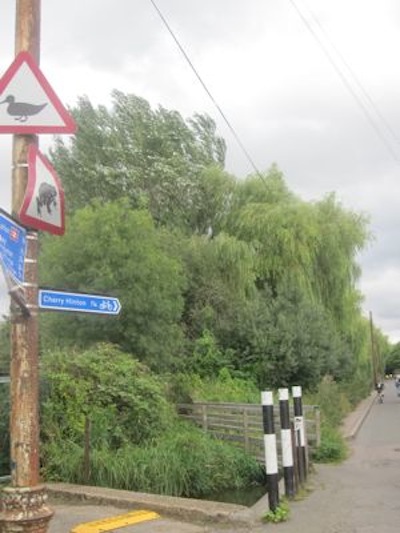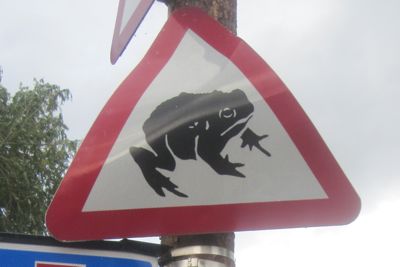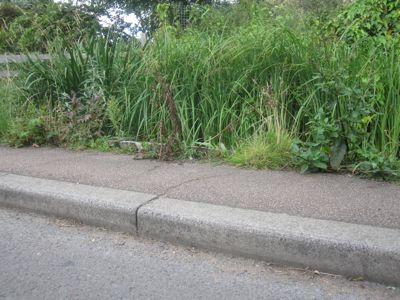
Councillors at Cambridge City Council’s East Area Committee on the 19th of August 2010 told officers to go ahead with, and give a high priority to, installing two thousand five hundred pounds worth of toad crossings at Burnside. These crossings are to take the form of dropped curbs. Councillors appeared to make the decision to spend public money on the project without having the question of if toads can jump the existing curbs or or not answered.
Public sector spending restraint has clearly not yet hit East Cambridge.
Background To The Project
The minutes of the East Area Committee held on the 15th of April 2010 state:
A toad crossing on Burnside had been added to the EIP (Environmental Improvements Programme).
That is the first mention of the toad crossing in the public record. It is not included in the EIP report to the April meeting. The minutes contain no description of the proposals or any record of any debate on the matter. No councillor’s name is publicly associated with the inception of the project.
My notes from the April 2010 meeting however record that was an introduction to the project from a council officer and this prompted quite some response from astonished local residents present. First residents suggested there already was a toad facility on Burnside – they told councillors they thought an existing gap in the curb by the footbridge to The Tins cycle path allowed toads to return to the water.

Public speakers also suggested, that as a cheaper option, the warning triangle, alerting drivers to the possibility of toads on the road, could be replaced (They appeared under the mistaken impression it had been removed; I think it has been moved though to a position out of most people’s line of sight). A public speaker also noted that local residents were able to help toads they found on the road over the curb if necessary. No councillors or officers responded to these comments.
The EIP report to the subsequent meeting, on the 17th of June, included an estimate of the cost of the work and gave a little more detail of the proposal, explaining it is intended to help toads along the length of Burnside. The single sentence present on the project states:
The lowering of the kerbs and slopping of the adjacent verge at four points along Burnside is estimated to cost £2000.
The minutes of the East Area Committee on the 17th June make no mention whatsoever of the toad crossing; I made no note on the subject there either suggesting it was not discussed at all.
By the August meeting of the East Area committee the cost of the toad crossings had risen, with the EIP report to that meeting stating;
The lowering of the kerbs and sloping of the adjacent verge at four points along Burnside is estimated to cost £2500.

At the August meeting new Petersfield councillor Sarah Brown spoke to ask: “Can’t Toads Jump”; she appeared to be trying to hide her disbelief at the prospect of he colleagues spending £2500 of public money on this project by muttering her comment at a level rendering it impossible for many present to hear. Liberal Democrats appear to try to avoid conflict, even if this means not speaking up about things they think are wrong. Cllr Smart decided it was a point worth all present hearing and she repeated Cllr Brown’s words clearly into a microphone for everyone’s benefit.
Once the toad crossing had been raised, as happened in April, a member of the public with local with some local knowledge spoke up. They noted the unexplained increasing cost of the project – claiming that when they first heard it suggested it was only going to cost £1,000, and it had initially risen to £2,000 and was now at £2,500. They also questioned the need for the work, on the basis they hadn’t seen any toads on the road recently.
The council officer responsible for Environmental Improvements, Mr Preston did not address either Cllr Brown’s question or the comments made by the member of the public. Cllr Herbert, the meeting’s chair appeared to be trying to hurry things along and didn’t seem to be keen to spend much, if any, time discussing toads.
Green party councillor Adam Pogonowski was the only other councillor to comment on the project. After having explained that he generally takes a “bio-sympathetic viewpoint” he expressed incredulity as he questioned why the toad crossing was being given a high priority classification, the same level of priority as something he thought was a much more significant problem – dealing with muddy grass verges in the East Area. As no other councillors had indicated any dissent to the prioritisation the meeting’s chair Cllr Herbert appeared to indicate that Cllr Pogonowski was being impertinent to push the issue to a vote. Cllr Herbert and I think Cllr Pogonowski were surprised that some of the Liberal Democrats who don’t speak, stuck their hands up to support Cllr Pogonowski and his motion was passed (4:2, with many Cllrs abstaining). The result of the vote meant a “very high” priority was assigned to dealing with grass verges, putting them a fraction ahead of the toad crossings, which were given a priority of merely “high”.
My View
A webpage on the Burnside allotments states:
The most commonly seen amphibian is the aptly named common toad, which is very numerous especially in damp places such as piles of wood or compost heaps (turning over compost heaps must be done with care!).There are also common frogs on site.
It appears that we’re dealing with a species which at least locally is present in very healthy numbers and isn’t in any way endangered or threatened. Also there are no curbs directly between toads in the allotments and the water; the curbs are only a hurdle to toads approaching the water directly from properties on Burnside.
- The curbs appear quite new; the committee ought ask officers to look into why any problem was not anticipated and ensure the same situation doesn’t arise again. (Clearly there’s a lack of thinking in local councils about effects of new barriers on wildlife as the recently built guided bus has been reported to trap toads too).
- As usual with public sector procurement the costs involved here are far too high; if there is a need to do something then perhaps the cheapest option would be to remove a couple of curbs stones in the middle of the burnside and make good with some tarmac . It’s a short stretch and toads can already get round at either end, I’d have thought a couple of hundred pounds would go a long way.
- In situations like this where the toad crossing appears to be me to be a luxury extra and not a major problem I think the role of taxpayers and councillors ought not be to provide the funds but merely to facilitate action; ie. just as you can pay for a dropped curb outside your house if the council agrees to it; toad lovers ought be able to pay for toad crossings if they can persuade councillors to allow them. (I would expect toad lovers might direct their resources more efficiently than councillors)
- If there are rare, seasonal, problems then perhaps a less costly more community focused solution could be found. eg. a cheap temporary sign which could be kept at the allotments and deployed when there are toads on the road, this could be used to alert motorists and also encourage members of the public to help any struggling toads. Last March on Stanley Street a local resident appears to have taken it upon themselves to graffiti the road with a warning about toads on the road. (While a sign might have been better, this shows there are people prepared to take action without state assistance and state funding. )
- It may be that survival of the fittest (and smartest) has already solved the problem as it sounds as if this year’s toads are not ending up stuck on the road.
- Adding the Burnside site to Froglife’s online list of toad crossings might result assist in recruiting more people to voluntarily patrol – it appears a sites elsewhere in and around Cambridge are known and people regularly provide help to many toads trying to cross roads. According to the Froglife Map there’s a site in Madingley where over 1,000 toads have been helped (there is a BBC article on it too).
13 responses to “Councillors Assign High Priority to Spending £2.5K on Burnside Toad Crossings”
Hi Richard,
My comment was that I take a ‘biocentric’ outlook on life, though I actually was supposed to say ecocentric.
Additionally, the Abbey verges are not only muddy, but broken from busses driving over them, and in places too narrow to allow driving past them, hence the widening! They do become mud baths in winter, though!
Only one Lib Dem supported me though; that was Cllr Saunders.
it could have been worse :
£190,000 for a dormouse crossing in south wales!
http://www.dailymail.co.uk/news/article-1305672/190k-bridges-road-DORMICE-footed-taxpayer.html
£190,000 for THREE crossings, new ponds, 60 doormouse boxes, and the otherwise required ecological survey.
Lucy,
You harm your argument by misrepresenting the facts.
Sara,
The Daily Mail says the £190,000 was for one bridge. It doesn’t give the cost of all three bridges and the associated works. I wouldn’t be surprised the the newspaper was wrong, but you’ve not provided an alternative, more reliable source.
The Cambridge News has now covered the Toad Crossing:
http://www.cambridge-news.co.uk/Home/Lower-kerbs-will-curb-toad-road-massacres.htm
A study by Froglife and partners from The University of Zurich in Switzerland has shown that on average common toads have declined by 68% over the last 30 years in the UK. In some areas, such as the south east of England, declines have been even more pronounced.It is not clear what has caused numbers of toads to drop so dramatically but likely causes are a combination of changes to farming practices, loss of ponds, an increase in urbanisation and more deaths on roads as traffic values have increased. Climate change could also be a factor as research has shown that milder winters are detrimental for hibernating toads.So please any body who can help with the migration please help.